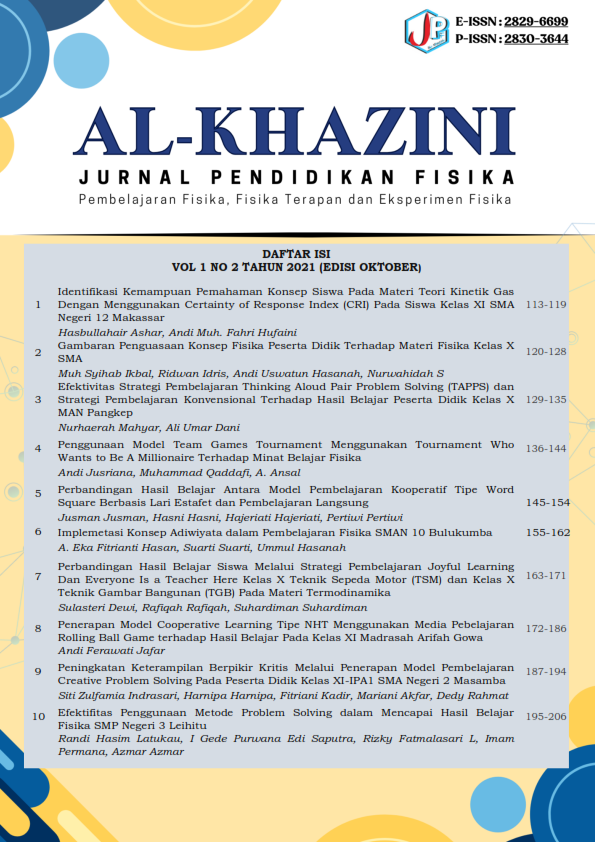Peningkatan Keterampilan Berpikir Kritis Melalui Penerapan Model Pembelajaran Creative Problem Solving Pada Peserta Didik Kelas XI-IPA1 SMA Negeri 2 Masamba
DOI:
https://doi.org/10.24252/al-khazini.v1i2.26607Keywords:
Model Pembelajaran, Creative Problem Solving, Keterampilan Berpikir KreatifAbstract
The objective of this research is to improve critical thinking skill of students class XI Science 1 at SMA Negeri 2 Masamba through creative problem solving learning model. This is a class action research by subjet of student of class XI. Science I at problem solving. Masamba of academic year 2015/2016 whiech consis 36 students.The result is show that (1) learning activities of students thaught by creative problem solving learning model have improvie from cycle I to cycle II (2) observation result of learning manegement by teacher on the cycle 1 and cycle II over 80% thus it is categorized is very good (3) the average (3) the average value of the results of the test of critical thinking skills of students has increased from the first cycle of 72 to 81 in the second cycle, (4) the thoroughness of the individual and the traditional skills of critical thinking of students has increased from 62.86% in the first cycle to 88.57 % in the second cycle.
Downloads
References
[2] Depdiknas. 2013. Kurikulum 2013: Implementasi Kurikulum 2013 Sekolah Menengah Atas dan Madrasah Aliyah. Jakarta: Depdiknas.
[3] Dwijananti. 2010. Pengembangan Kemampuan Berpikir Kritis Mahasiswa melalui Pembelajaran Problem Based Instruction pada Mata Kuliah Fisika Lingkungan. Jurnal Pendidikan Fisika Indonesia
[4] Elaine B Johnson. 2007. Contextual Teaching and Learning. Bandung: MLC
[5] Indrayani, Putri. 2012. Model Pembelajaran Creative Problem Solving (CPS) dengan pendekatan open ended untuk meningkatkan kemampuan berfikir kritis peserta didik kelas VIII E SMP Negeri 13 Malang. Tesis. Malang: Universitas Negeri Malang.
[6] Maraviglia, F., and Kvashny, A. 2006. Managing Virtual Change: A Guide to Creative ProblemSolving in Design Professions (Published in 2006 by Author House Publishing).
[7] Gains in Physics. American Journal of Physics, 70 (7). Merrill/Prentice Hall.
[8] Mulyasa. 2011. Metode Penelitian Tindakan Kelas. Bandung: Pustaka Setia.
[9] Muslich, M. 2007. Pembelajaran Berbasis Kompotensi dan Kontekstual. Jakarta: Bumi Aksara.
[10] Myrmel, M. K. 2003. Effek of Using Creative Problem Solving in Eight Grade Tegnology Education Class At Hopkins North Junior High School. Research Paper to Submittedin Partial Fulfillment of The Requirenment for Master of Science Degree. The Graduate Scholl University of Wincinsin: Stout [Online]. Tersedia: http://www.scirus.com
[11] OECD. 2012. PISA 2012 Results in Focus. https://www.oecd.org/pisa/keyfindings/pisa-2012-results-overview.pdf
[12] Pepkin, K. L. 2004. Creative Problem Solving in Math. Tersedia di: http://www.uh.edu/hti/cu/2004/v02/04.htm
[13] Peraturan Menteri Pendidikan Nasional Republik Indonesia Nomor 22 Tahun 2006 Tentang Standar Isi Untuk Satuan Pendidikan Dasar dan Menengah.
[14] Peraturan Menteri Pendidikan Nasional Republik Indonesia Nomor 41 Tahun 2007
[15] Tentang Standar Proses untuk Satuan Pendidikan Dasar dan Menengah.
[16] Sakka, Jamaluddin. 2011. Efektivitas Pembelajaran Kontekstual terhadap Peningkatan Kemampuan Berpikir Kritis dan Berpikir Kreatif pada Pembelajaran Fisika Peserta Didik Kelas X SMA Negeri 8 Makassar. Skripsi. Karya Tidak Diterbitkan. Makassar: Universitas Negeri Makassar.
[17] Sanjaya, Wina. 2011. Strategi Pembelajaran Berorientasi Standar Proses Pendidikan. Jakarta: Kencana.
[18] Suryosubroto. 2009. Proses Belajar Mengajar di Sekolah. Jakarta: PT. Rineke Cipta.
[19] Sujarwo. 2006. Strategi Creative Problem Solving dalam Pemecahan Masalah. Majalah Ilmiah Pembelajaran. No.1.Vol 2.Mei2006. http://jurnal.pdii.lipi.go.id/admin/jurnal/21061327.pdf.
[20] Tawil, Muhammad. 2011. Keterampilan Berpikir Kritis dan Kreatif. Karya tidak diterbitkan.
[21] Treffinger & Isaksen . 2008. Understanding Individual Problem-Solving Style: A key to Learning and Applying Creative Problem Solving. Learning and Individual Differences, 18,390-401
[22] Wiriaatmadja, R. 2006. Metode penelitian Tindakan Kelas. Bandung: Remaja Rosdakarya.
Downloads
Published
How to Cite
Issue
Section
License
The Authors submitting a manuscript do so on the understanding that if accepted Al-Khazini:Jurnal Pendidikan Fisika for publication, copyright publishing of the article shall be assigned/transferred to Physics Education Department, UIN Alauddin Makassar as Publisher of the journal. Upon acceptance of an article, authors will be asked to complete a 'Copyright Transfer Agreement'. An e-mail will be sent to the corresponding author confirming receipt of the manuscript together with a 'Copyright Transfer Agreement' form by the online version of this agreement.
Al-Khazini:Jurnal Pendidikan Fisika and Physics Education Department, UIN Alauddin Makassar, , and Physics Society of Indonesia as the Editors and the Advisory International Editorial Board make every effort to ensure that no wrong or misleading data, opinions or statements be published in the journal. In any way, the contents of the articles and advertisements published in the Al-Khazini:Jurnal Pendidikan Fisika are the sole and exclusive responsibility of their respective authors and advertisers.
The copyright form should be signed electronically and send to the Editorial Office in the form of the original e-mail: [email protected]



















